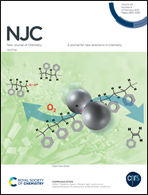Functionalized resorcin[4]arene-based coordination polymers as heterogeneous catalysts for click reactions†
Abstract
Three distinctive coordination polymers [Cu2L2]·0.5CH3OH·1.5H2O·2CN (1), [CdCl2L]·5DMF·2CH3OH·2H2O (2) and [Cd2L(bdc)2(DMF)]·2DMF·3CH3OH·H2O (3) were solvothermally synthesized using a resorcin[4]arene ligand (H2bdc = p-phthalic acid and L = tetrakis(4-mercaptopyridine-ylmethyl)resorcin[4]arene). Among them, 1 exhibits a 3D structure, but 2 and 3 are both charming layers. 1 exhibits efficient and selective catalytic performance for azide–alkyne cycloaddition reactions owing to its rich Lewis acid sites. Remarkably, as a heterogeneous catalyst, 1 could be recycled with preservation of the catalytic capability and structural integrity.
![Graphical abstract: Functionalized resorcin[4]arene-based coordination polymers as heterogeneous catalysts for click reactions](/en/Image/Get?imageInfo.ImageType=GA&imageInfo.ImageIdentifier.ManuscriptID=D0NJ06051H&imageInfo.ImageIdentifier.Year=2021)


 Please wait while we load your content...
Please wait while we load your content...